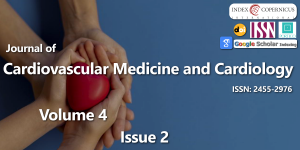The Changes of Myocardium in Minipigs after Coronary Vein Ligation Observed by Transmission Electron Microscopy
Main Article Content
Abstract
Background: The study of coronary artery disease has been quite thorough. But there is few study on coronary vein disease. In clinical practice, some patients have suspicious symptoms of coronary artery disease without any evidence of coronary artery spasm, but coronary angiography showed no obvious stenosis in coronary artery. It may have relationship to coronary venous dysfunction. This study aims to develop a coronary vein ligation model, to investigate the effect of coronary vein occlusion on myocardial cells in normal miniature pigs.
Methods: Adult minifies were divided into control group and intervention group. The coronary venous occlusion model was made by clamping the central vein. Myocardium was isolated from the myocardium and the myocardium was observed by transmission electron microscopy.
Results: There were no significant changes in the sham operation group (control group). Mitochondrial edema, cristae broken, hyperplasia and auto phage some appeared in the operation group (intervention group).
Conclusion: The ligation of the coronary vein causes dysfunction of myocardial cells. It gives us inspiration, coronary vein occlusive disease may be underestimated. It may be some causes of angina for patients with normal coronary angiography.
Downloads
Article Details
Copyright (c) 2017 Wang J, et al.

This work is licensed under a Creative Commons Attribution 4.0 International License.
Schoffel N, Opitz C, Spencker S (2011) [ECG, laboratory values and coronary angiography normal: what is the cause of angina pectoris? Prinzmetal angina]. MMW Fortschr Med 153: 5. Link: https://goo.gl/uUd6m6
Di Fiore DP, Beltrame JF (2013) Chest pain in patients with 'normal angiography': could it be cardiac? Int J Evid Based Healthc 11: 56-68. Link: https://goo.gl/VUU4CD
Radico F, Cicchitti V, Zimarino M, Caterina RD (2014) Angina pectoris and myocardial ischemia in the absence of obstructive coronary artery disease: practical considerations for diagnostic tests. JACC Cardiovasc Interv 7: 453-63. Link: https://goo.gl/R0Dd2Q
Ockene IS, Shay MJ, Alpert JS, Weiner BH and Dalen JE (1980) Unexplained chest pain in patients with normal coronary arteriograms: a follow-up study of functional status. N Engl J Med 303: 1249. Link: https://goo.gl/jYekYd
Vural A, Kiliç T, Ural E, Ural D (2009) [Implantation of the left ventricular pacemaker lead after successful balloon angioplasty for coronary vein stenosis: a report of two cases]. Turk Kardiyol Dern Ars 37: 201-204. Link: https://goo.gl/6Aabpx
Aras D, Ozeke O, Baskok FA, Avci S, Cebeci M, et al. (2015) Early coronary vein stenosis after cardiac resynchronization therapy. Herz 40: 165-168. Link: https://goo.gl/Q74HHF
Lu C (2016) Angina caused by coronary vein, in Health News p. 008.
Menasche P, Subayi JB and Piwnica A (1990) Retrograde coronary sinus cardioplegia for aortic valve operations: a clinical report on 500 patients. Ann Thorac Surg 49: 556-563. Link: https://goo.gl/7LgIuC
Kaul TK, Fields BL and Jones CR (2000) Laterogenic injuries during retrograde delivery of cardioplegia. Cardiovasc Surg 8: 400-403. Link: https://goo.gl/mAUzBa
Care NRCU and AUOL Animals (2011) Guide for the Care and Use of Laboratory Animals. The National Academies Collection: Reports funded by National Institutes of Health. Washington (DC): National Academies Press (US). Link: https://goo.gl/wODkdZ
Yin Q, Zhao Y, Wang H, Pei Z (2013) [Delayed-enhanced magnetic resonance imaging for assessing a minipig myocardial infarction model established by percutaneous balloon occlusion]. Nan Fang Yi Ke Da Xue Xue Bao 33: 34-39. Link: https://goo.gl/cjPDzo
Dubois G, Segers VF, Bellamy V, Sabbah L, Peyrard S, et al. (2008) Self-assembling peptide nanofibers and skeletal myoblast transplantation in infarcted myocardium. J Biomed Mater Res B Appl Biomater 87: 222-228. Link: https://goo.gl/bK81Sx
Kang S, Yang YJ, Wu YL, Chen YT, Li L, et al. (2010) Myocardium and microvessel endothelium apoptosis at day 7 following reperfused acute myocardial infarction. Microvasc Res 79: 70-79. Link: https://goo.gl/1OwWEi
Goto M, Miwa H, Suganuma K, Tsunekawa-Imai N, Shikami M, et al. (2014) Adaptation of leukemia cells to hypoxic condition through switching the energy metabolism or avoiding the oxidative stress. BMC Cancer 14: 76. Link: https://goo.gl/5B1r2b
Zhang JL, Lu JK, Chen D, Cai Q, Li TX, et al. (2009) Myocardial autophagy variation during acute myocardial infarction in rats: the effects of carvedilol. Chin Med J (Engl) 122: 2372-2379. Link: https://goo.gl/SoK3cc
McLachlan CS, Almsherqi ZA, Chua KS, Liew YY, Low CW, et al. (2007) Acute coronary ligation in the dog induces time-dependent transitional changes in mitochondrial crista in the non-ischaemic ventricular myocardium. Clin Exp Pharmacol Physiol 34: 250-253. Link: https://goo.gl/eTk9Gq
Giannini F, Aurelio A and Chieffo A (2016) [Coronary Sinus Reducer implantation: a new treatment for chronic refractory angina]. G Ital Cardiol (Rome) 17: 3S-9. Link: https://goo.gl/ViKuE3
Konigstein M, Verheye S, Jolicœur EM, Banai S (2016) Narrowing of the Coronary Sinus: A Device-Based Therapy for Persistent Angina Pectoris. Cardiol Rev 24: 238-243. Link: https://goo.gl/ThJT39





